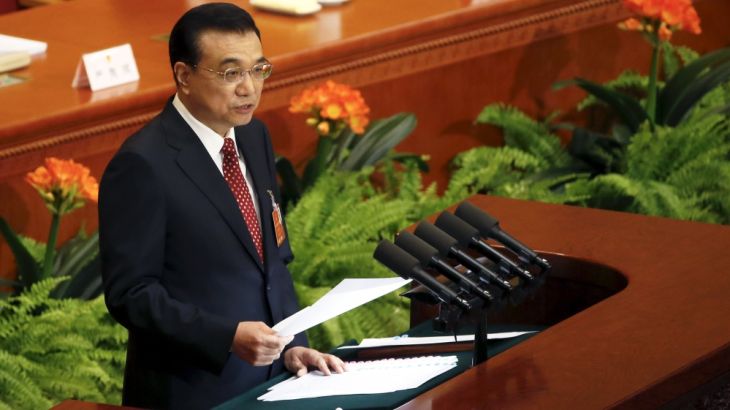China aims to steady the ship amid financial crisis
At annual congress in Beijing, Premier Li Keqiang outlines nation’s five-year plan, including 6.5-7% growth.

China is aiming for average economic growth at or above 6.5 percent for the next five years, the government said, as the world’s second-largest economy seeks to balance deep structural reforms, gyrating financial markets, and softening global trade.
Unveiling a draft of the new five-year development plan at the annual National People’s Congress, Premier Li Keqiang said on Saturday that China would target economic growth between 6.5-7 percent in 2016.
Keep reading
list of 4 itemsWhy are nations racing to buy weapons?
Parallel economy: How Russia is defying the West’s boycott
US House approves aid package worth billions for Ukraine, Israel
Weighed down by sluggish demand at home and abroad, industrial overcapacity, and faltering investment, China’s economic growth slowed to 6.9 percent in 2015, its weakest in a quarter of a century. Economists expect it to cool further to around 6.5 percent this year.
|
|
Al Jazeera’s Adrian Brown, reporting from Beijing, said the growth figure was what economists the world over have been looking out for after dramatic losses on China’s stock market over the past year.
“The message of [Premier Li] today is: ‘Yes, 2015 was a difficult year, not just for China, but for the world … but we pulled through it because of the vision and the programmes of the Chinese Communist Party’,” Brown said.
Brown said the premier acknowledged during his lengthy speech there were still many “inadequacies” within the government that need to be addressed.
“He pointed out that some reforms have still not been implemented … and that corruption and misconduct cannot be ignored,” he said, adding it was a strong indication that the government’s crackdown on its “rotten” elements would continue.
China’s 13th five-year plan is a blueprint for economic and social development between 2016 and 2020.
In the week leading up to the congress, the government flagged major job losses in the key production industries of coal and steel as policymakers seek to eliminate inefficiencies and overcapacity in state-owned enterprises through consolidation and layoffs.
China aims to lay off five to six million state workers over the next two to three years, two sources said, Beijing’s boldest retrenchment programme in almost two decades.
China’s leadership, eager to maintain stability and ensure redundancies do not lead to unrest, will spend nearly 150 billion yuan ($23bn) to cover layoffs in just the coal and steel sectors in the next two to three years.
But Li also said the country will create 10 million new jobs and hold the urban registered unemployment rate below 4.5 percent in 2016.
China will increase military spending by 7.6 percent this year, its lowest increase in six years, as the premier vowed to push on with a modernisation plan that will shrink staffing.
Al Jazeera’s Brown said another target introduced on Saturday was the goal to have 60 percent of the country living in cities and to have trains linking 80 percent of the nation’s cities.
Every year around 3,000 delegates from across the country meet in Beijing’s Great Hall of the People for the National People’s Congress (NPC) that lasts 12 days.
|
|
The delegates attending the session represent China’s 31 provinces, municipalities and autonomous regions, as well as Hong Kong, Macau, and the military. There are also delegates for self-ruled Taiwan, made up of defectors and their descendants. They serve five-year terms.
The largely ceremonial advisory body, the Chinese People’s Political Consultative Conference, meets in parallel with the NPC. It is made up of business magnates, artists, monks, non-communists, and other representatives of broader society, but it has no legislative power.
While the congress is commonly considered a rubber-stamp body – applied to economic and political goals decided at the higher levels of the Chinese Communist Party’s leadership – debates can still be lively.
It is also a chance for officials from around the country to meet and exchange ideas: from sophisticated urbanites to the leaders of poor rural counties, along with celebrities, business executives, and regulators.
|
|